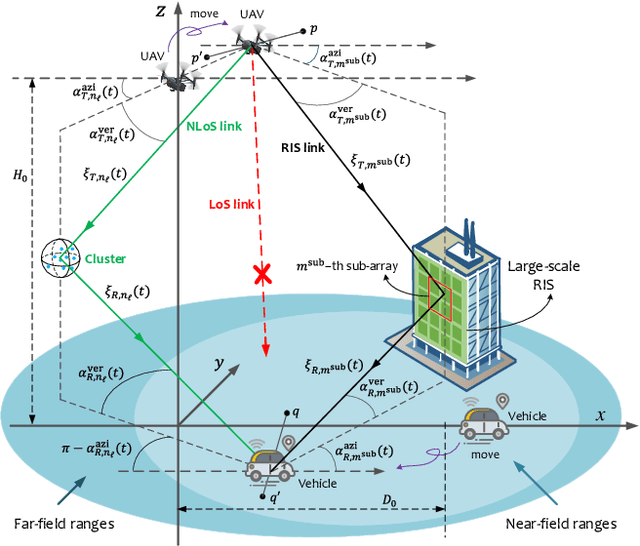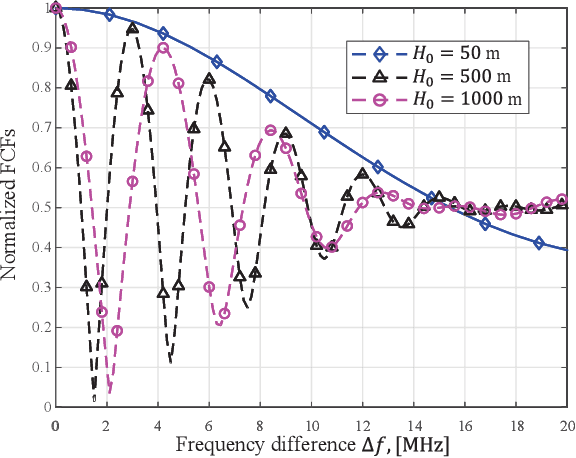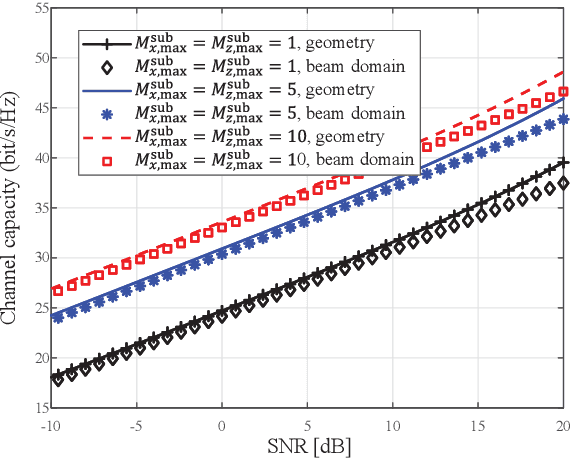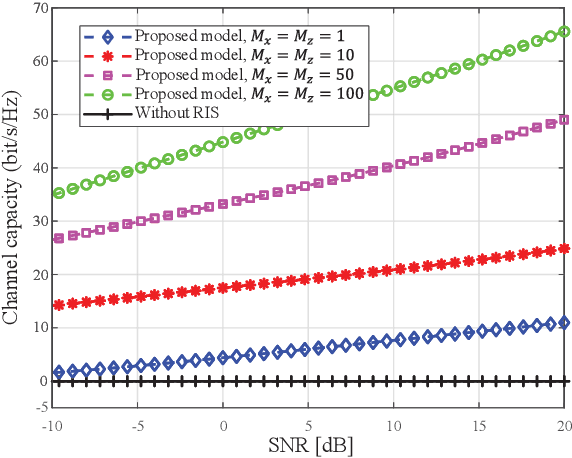Zaichen Zhang
National Mobile Communications Research Laboratory, Quantum Information Center, Southeast University, China
Probabilistic ODMA Receiver with Low-Complexity Algorithm for MIMO Unsourced Random Access
May 05, 2025Abstract:In this work, we present the design for both pilot-uncoupled and pilot-free on-off multiple access (ODMA) receivers in unsourced random access (URA) for multiple-input multiple-output (MIMO) systems. Unlike pilot-coupled ODMA, where on-off patterns are linked to pilot selection, pilot-uncoupled and pilot-free ODMA reduce transmission redundancy but face challenges in processing complexity and capacity performance. The joint pattern and data detector (JPDD) design is critical for these schemes, but the current JPDD algorithm has high complexity with quadratic computational costs. To address this, we propose a low-complexity detector based on approximate message passing (AMP), which offers linear complexity, providing reduced cost and improved performance in the under-determined linear regression case. Decoding is initialized via pilot-free matrix factorization through alternating minimization, resolving phase and scalar ambiguities. Compared to existing pilot-free schemes, the proposed method achieves a 13 dB improvement and favorable trade-offs in complexity and capacity performance when compared to benchmarks.
Prototyping and Experimental Results for ISAC-based Channel Knowledge Map
Aug 12, 2024



Abstract:Channel knowledge map (CKM) is a novel approach for achieving environment-aware communication and sensing. This paper presents an integrated sensing and communication (ISAC)-based CKM prototype system, demonstrating the mutualistic relationship between ISAC and CKM. The system consists of an ISAC base station (BS), a user equipment (UE), and a server. By using a shared orthogonal frequency division multiplexing (OFDM) waveform over the millimeter wave (mmWave) band, the ISAC BS is able to communicate with the UE while simultaneously sensing the environment and acquiring the UE's location. The prototype showcases the complete process of the construction and application of the ISAC-based CKM. For CKM construction phase, the BS stores the UE's channel feedback information in a database indexed by the UE's location, including beam indices and channel gain. For CKM application phase, the BS looks up the best beam index from the CKM based on the UE's location to achieve training-free mmWave beam alignment. The experimental results show that ISAC can be used to construct or update CKM while communicating with UEs, and the pre-learned CKM can assist ISAC for training-free beam alignment.
Active RIS-Aided Massive MIMO With Imperfect CSI and Phase Noise
May 06, 2024



Abstract:Active reconfigurable intelligent surface (RIS) has attracted significant attention as a recently proposed RIS architecture. Owing to its capability to amplify the incident signals, active RIS can mitigate the multiplicative fading effect inherent in the passive RIS-aided system. In this paper, we consider an active RIS-aided uplink multi-user massive multiple-input multiple-output (MIMO) system in the presence of phase noise at the active RIS. Specifically, we employ a two-timescale scheme, where the beamforming at the base station (BS) is adjusted based on the instantaneous aggregated channel state information (CSI) and the statistical CSI serves as the basis for designing the phase shifts at the active RIS, so that the feedback overhead and computational complexity can be significantly reduced. The aggregated channel composed of the cascaded and direct channels is estimated by utilizing the linear minimum mean square error (LMMSE) technique. Based on the estimated channel, we derive the analytical closed-form expression of a lower bound of the achievable rate. The power scaling laws in the active RIS-aided system are investigated based on the theoretical expressions. When the transmit power of each user is scaled down by the number of BS antennas M or reflecting elements N, we find that the thermal noise will cause the lower bound of the achievable rate to approach zero, as the number of M or N increases to infinity. Moreover, an optimization approach based on genetic algorithms (GA) is introduced to tackle the phase shift optimization problem. Numerical results reveal that the active RIS can greatly enhance the performance of the considered system under various settings.
Large-Scale RIS Enabled Air-Ground Channels: Near-Field Modeling and Analysis
Mar 19, 2024



Abstract:Existing works mainly rely on the far-field planar-wave-based channel model to assess the performance of reconfigurable intelligent surface (RIS)-enabled wireless communication systems. However, when the transmitter and receiver are in near-field ranges, this will result in relatively low computing accuracy. To tackle this challenge, we initially develop an analytical framework for sub-array partitioning. This framework divides the large-scale RIS array into multiple sub-arrays, effectively reducing modeling complexity while maintaining acceptable accuracy. Then, we develop a beam domain channel model based on the proposed sub-array partition framework for large-scale RIS-enabled UAV-to-vehicle communication systems, which can be used to efficiently capture the sparse features in RIS-enabled UAV-to-vehicle channels in both near-field and far-field ranges. Furthermore, some important propagation characteristics of the proposed channel model, including the spatial cross-correlation functions (CCFs), temporal auto-correlation functions (ACFs), frequency correlation functions (CFs), and channel capacities with respect to the different physical features of the RIS and non-stationary properties of the channel model are derived and analyzed. Finally, simulation results are provided to demonstrate that the proposed framework is helpful to achieve a good tradeoff between model complexity and accuracy for investigating the channel propagation characteristics, and therefore providing highly-efficient communications in RIS-enabled UAV-to-vehicle wireless networks.
Performance Trade-off and Joint Waveform Design for MIMO-OFDM DFRC Systems
Jan 04, 2024Abstract:Dual-functional radar-communication (DFRC) has attracted considerable attention. This paper considers the frequency-selective multipath fading environment and proposes DFRC waveform design strategies based on multiple-input and multiple-output (MIMO) and orthogonal frequency division multiplexing (OFDM) techniques. In the proposed waveform design strategies, the Cramer-Rao bound (CRB) of the radar system, the inter-stream interference (ISI) and the achievable rate of the communication system, are respectively considered as the performance metrics. In this paper, we focus on the performance trade-off between the radar system and the communication system, and the optimization problems are formulated. In the ISI minimization based waveform design strategy, the optimization problem is convex and can be easily solved. In the achievable rate maximization based waveform design strategy, we propose a water-filling (WF) and sequential quadratic programming (SQP) based algorithm to derive the covariance matrix and the precoding matrix. Simulation results validate the proposed DFRC waveform designs and show that the achievable rate maximization based strategy has a better performance than the ISI minimization based strategy.
Integrated Sensing and Channel Estimation by Exploiting Dual Timescales for Delay-Doppler Alignment Modulation
Oct 17, 2023Abstract:For integrated sensing and communication (ISAC) systems, the channel information essential for communication and sensing tasks fluctuates across different timescales. Specifically, wireless sensing primarily focuses on acquiring path state information (PSI) (e.g., delay, angle, and Doppler) of individual multi-path components to sense the environment, which usually evolves much more slowly than the composite channel state information (CSI) required for communications. Typically, the CSI is approximately unchanged during the channel coherence time, which characterizes the statistical properties of wireless communication channels. However, this concept is less appropriate for describing that for wireless sensing. To this end, in this paper, we introduce a new timescale to study the variation of the PSI from a channel geometric perspective, termed path invariant time, during which the PSI largely remains constant. Our analysis indicates that the path invariant time considerably exceeds the channel coherence time. Thus, capitalizing on these dual timescales of the wireless channel, in this paper, we propose a novel ISAC framework exploiting the recently proposed delay-Doppler alignment modulation (DDAM) technique. Different from most existing studies on DDAM that assume the availability of perfect PSI, in this work, we propose a novel algorithm, termed as adaptive simultaneously orthogonal matching pursuit with support refinement (ASOMP-SR), for joint environment sensing and PSI estimation. We also analyze the performance of DDAM with imperfectly sensed PSI.Simulation results unveil that the proposed DDAM-based ISAC can achieve superior spectral efficiency and a reduced peak-to-average power ratio (PAPR) compared to standard orthogonal frequency division multiplexing (OFDM).
Dynamic Sub-array Based Modeling for Large-Scale RIS-assisted mmWave UAV Channels
Jul 24, 2023Abstract:Large-scale reconfigurable intelligent surface (RIS) can effectively enhance the performance of millimeter wave (mmWave) unmanned aerial vehicle (UAV) to ground communication link with obstructed line-of-sight (LoS) path by exploiting more reflecting units. However, the non-negligible array dimension of large-scale RIS and the mobile property of the terminals bring significant variations in propagation characteristics, making conventional channel models inapplicable. To address this issue, we propose a dynamic sub-array partition scheme to divide the large-scale RIS into sub-arrays by exploiting the Rayleigh distance criterion and the mobile property of the transceivers. Based on the proposed scheme, a novel non-stationary channel model for large-scale RIS auxiliary mmWave UAV-to-ground mobile networks is developed, which outperforms existing models with well balance between model complexity and accuracy. Numerical results are provided to verify our analysis.
Channel Modeling for Heterogeneous Vehicular ISAC System with Shared Clusters
Jul 16, 2023



Abstract:In this paper, we consider the channel modeling of a heterogeneous vehicular integrated sensing and communication (ISAC) system, where a dual-functional multi-antenna base station (BS) intends to communicate with a multi-antenna vehicular receiver (MR) and sense the surrounding environments simultaneously. The time-varying complex channel impulse responses (CIRs) of the sensing and communication channels are derived, respectively, in which the sensing and communication channels are correlated with shared clusters. The proposed models show great generality for the capability in covering both monostatic and bistatic sensing scenarios, and as well for considering both static clusters/targets and mobile clusters/targets. Important channel statistical characteristics, including time-varying spatial cross-correlation function (CCF) and temporal auto-correlation function (ACF), are derived and analyzed. Numerically results are provided to show the propagation characteristics of the proposed ISAC channel model. Finally, the proposed model is validated via the agreement between theoretical and simulated as well as measurement results.
Downlink Precoding for Cell-free FBMC/OQAM Systems With Asynchronous Reception
Jul 13, 2023



Abstract:In this work, an efficient precoding design scheme is proposed for downlink cell-free distributed massive multiple-input multiple-output (DM-MIMO) filter bank multi-carrier (FBMC) systems with asynchronous reception and highly frequency selectivity. The proposed scheme includes a multiple interpolation structure to eliminate the impact of response difference we recently discovered, which has better performance in highly frequency-selective channels. Besides, we also consider the phase shift in asynchronous reception and introduce a phase compensation in the design process. The phase compensation also benefits from the multiple interpolation structure and better adapts to asynchronous reception. Based on the proposed scheme, we theoretically analyze its ergodic achievable rate performance and derive a closed-form expression. Simulation results show that the derived expression can accurately characterize the rate performance, and FBMC with the proposed scheme outperforms orthogonal frequency-division multiplexing (OFDM) in the asynchronous scenario.
A Framework for Transmission Design for Active RIS-Aided Communication with Partial CSI
Feb 18, 2023



Abstract:Active reconfigurable intelligent surfaces (RISs) have recently been proposed to compensate for the severe multiplicative fading effect of conventional passive RIS-aided systems. Each reflecting element of active RISs is assisted by an amplifier such that the incident signal can be reflected and amplified instead of only being reflected as in passive RIS-aided systems. This work addresses the practical challenge that, on the one hand, in active RIS-aided systems the perfect individual CSI of the RIS-aided channels cannot be acquired due to the lack of signal processing power at the active RISs, but, on the other hand, this CSI is required to calculate the expected system data rate and RIS transmit power needed for transceiver design. To address this issue, we first derive closed-form expressions for the average achievable rate and the average RIS transmit power based on partial CSI of the RIS-aided channels. Then, we formulate an average achievable rate maximization problem for jointly optimizing the active beamforming at both the base station (BS) and the RIS. This problem is then tackled using the majorization--minimization (MM) algorithm framework, and, for each iteration, semi-closed-form solutions for the BS and RIS beamforming are derived based on the Karush-Kuhn-Tucker (KKT) conditions. To ensure the quality of service (QoS) of each user, we further formulate a rate outage constrained beamforming problem, which is solved using the Bernstein-Type inequality (BTI) and semidefinite relaxation (SDR) techniques. Numerical results show that the proposed algorithms can efficiently overcome the challenges imposed by imperfect CSI in active RIS-aided wireless systems.
 Add to Chrome
Add to Chrome Add to Firefox
Add to Firefox Add to Edge
Add to Edge